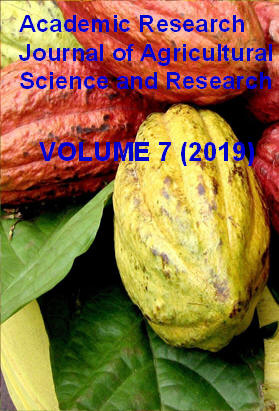|
ISSN: 2360-7874 |
Academic Research Journal of
Agricultural Science and Research |
|||||||||||||||||||
|
Vol. 7(7), pp. 513-529, November 2019 Research Review on Camel Brucellosis: Public health importance and status in Ethiopia.
Fekadu Gutema *1 and Juhar Tesfaye *2
1Ethiopian Institute of Agricultural research, Addis Ababa P.O. BOX 2003. 2 Ethiopian Institute of Agricultural research, Addis Ababa P.O.BOX 2003
Corresponding Author: fikadu881@gmail.com
Accepted 11 November 2019
In many developing countries of Africa and Asia, camels are the most important source of income for the Pastoral population through the provision of milk, meat, and transportation service. The chief role of the camel relates directly to its remarkable adaptation to extremely harsh conditions. However, these contributions of camels to the human welfare of developing countries are generally obscured by several factors, among which disease is the basic one. Brucellosis is one of the common bacterial diseases of a camel which is caused by genus Brucella resulting in substantial loss of production. Currently, ten species of brucella are recognized among which six of them are classical species. In dromedary camels, brucellosis can be caused by B. abortus; B. melitensis and B. ovis which results in significant loss of productivity through late first calving age, long calving interval time, low herd fertility and comparatively low milk production. The disease is found widespread in camel rearing regions of the world whereas age; sex; management and husbandry practice are considered as a major risk factor. The prevalence of camel brucellosis which was reported from different pastoral areas of Ethiopia is quite varying. Additionally; research conducted on camel brucellosis is scarce and is limited only to serological study with no confirmed isolation of Brucella bacteria. In humans, brucellosis is a debilitating disease with nonspecific symptoms and infertility being the common sequelae. The disease is transmitted by contact with infected animals; consumption of unpasteurized dairy products and undercooked meat. To treat brucellosis in humans, several conventional antibiotics are used in clinics and can also be controlled through milk pasteurization and hygienic measures coupled with effective disease surveillance and animal movement control. Generally, to combat the public health and economic significance of camel brucellosis detailed studies for isolation and characterization the causative agent of camel brucellosis should be implemented along with enhancing awareness level of the society.
Key words: Brucellosis, Camel, Ethiopia, zoonosis, Seroprevalence, Pastoralist
How to cite this article (APA Style): Fekadu G., Juhar T (2019). Review on Camel Brucellosis: Public health importance and status in Ethiopia. Acad. Res. J. Agri. Sci. Res. 7(7): 513-529
|
|||||||||||||||||||
